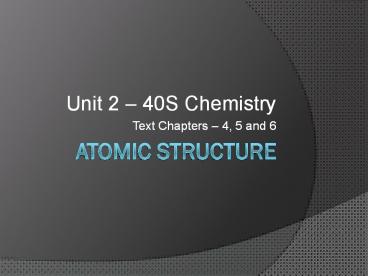Atomic%20structure - PowerPoint PPT Presentation
Title:
Atomic%20structure
Description:
New Approach to the Atom (Ch. 5) Electromagnetic Spectrum. Line spectra. Wave vs. Particle. Bohr Model. Heisenberg. Schrodinger. Quantum Mechanical Model – PowerPoint PPT presentation
Number of Views:117
Avg rating:3.0/5.0
Title: Atomic%20structure
1
Atomic structure
- Unit 2 40S Chemistry
- Text Chapters 4, 5 and 6
2
Early Theories (Chapter 4)
- John Dalton
- JJ Thomson
- Rutherford
- Bohr
3
New Approach to the Atom (Ch. 5)
- Electromagnetic Spectrum
- Line spectra
- Wave vs. Particle
- Bohr Model
- Heisenberg
- Schrodinger
- Quantum Mechanical Model
4
Electromagnetic Spectrum
- Entry Level Knowledge
- Grade 8 Electromagnetic Radiation
- How do we see different colors?
- Grade 12 Chemistry
- Light
- Wavelength
- Frequency
5
Electromagnetic Spectrum
- See light based upon the wavelengths of light
travelling to our eye. - How we see color, is our eyes detect the
wavelength of light that corresponds to that
color - Example If we see green all colors are
absorbed, and green light wavelength is reflected
back to our eye
6
Electromagnetic Spectrum
7
Electromagnetic Spectrum
- Wavelength is made of three parts
- Frequency
- Number of wave cycles to pass a given point per
unit of time (cycles per second or Hertz (Hz)) - Wavelength
- The distance between crests or troughs of a wave
- Amplitude
- The waves height from 0 to crest
8
Electromagnetic Spectrum
9
Electromagnetic Spectrum
- There is an inverse relationship between
wavelength and frequency - All light moves at the speed of light
- c 3.00 x 10 8 m/s
- Energy is a product of the frequency and the
speed of light - Therefore, the greater the frequency, the smaller
the wavelength and the more energy produced
10
Line Spectrum (Atomic Spectra)
- How does a light bulb glow?
- When atoms absorb energy, the electron moves to a
higher energy level and when it returns to its
ground state, energy is lost in the form of light - Each color corresponds to the energy lost, and a
specific frequency and wavelength
11
Line Spectrum (Atomic Spectra)
12
Line Spectrum (Atomic Spectra)
13
Line Spectrum (Atomic Spectra)
14
Line Spectrum (Atomic Spectra)
- Neils Bohr (p. 128 129)
- Found when an atom was excited light was given
off - Electron gains E, moves from its ground state, to
a higher E level, and then drops back to its
ground state, losing E in the form of light - Light corresponded to the energy given
- Greater the energy, greater the jump, smaller the
wavelength - 7 different colors of light, 7 energy levels
15
Line Spectrum (Atomic Spectra)
16
Line Spectrum (Atomic Spectra) Animation
17
Applications of Line Spectrum
- Aurora borealis
- Fireworks
- Neon Lights
18
Applications of Line Spectrum
19
Quantum Mechanical View of the Atom
- Heisenberg (page 145)
- Cannot predict where the electron is in space
- If on a rail, like Bohr suggested, should be able
to pinpoint where the electron is in space, but
we cannot - Heisenberg uncertainty principle
- We know the speed, momentum change and direction,
but cannot know all three
20
Quantum Mechanical View of the Atom
21
Quantum Mechanical View of the Atom
22
Quantum Mechanical View of the Atom
- Louis De Broglie (p. 144 145)
- Particles can act as waves
- Only see the wave if the particle is very small
- Uses
- Electron Microscopes
- Fiber Optics
23
Quantum Mechanical View of the Atom
24
Quantum Mechanical View of the Atom
- Erwin Schrodinger (p. 130 131)
- Quantum Mechanical View of the Atom
- The amount of E needed to move an electron from
one E level to the next is called a quantum. - The packet, or quantum of E, that light gives off
is called a photon. - The allowed energies of an electron are
determined by the area it occupies and were,
determined by probability, the electron will be
found around the nucleus
25
Quantum Mechanical View of the Atom
- Schrodingers Cat
- Models
26
Quantum Mechanical View of the Atom
27
Quantum Mechanical View of the Atom
28
Electron Arrangements
- E level Diagrams
- Electron Arrangements
- Orbital Filling
- Lewis Dot / Valence Levels (orbital filling)
- Electron Configurations
- Core Notation
29
Electron Arrangements
- Rules of Electron Arrangements
- Aufbau Principle
- German for building up
- Fill from the lowest E level to the highest
30
Electron Arrangements
- Rules of Electron Arrangements
- Pauli Exclusion Principle
- Only two electrons can occupy an orbital as long
as they have opposite spin - A vertical arrow indicates the direction of spin
31
Electron Arrangements
- Rules of Electron Arrangements
- Hunds Rule
- Electrons occupy orbitals of the same E, so that
the number of electrons with the same spin
direction, is as large as possible.
32
Electron Arrangements
- Electron Configurations
- Show the arrangement of electrons in the energy
levels and sub-levels - Core Notation
- The electron configuration, showing the inner
electrons, or core (Noble Gas) and the valence
electrons, in the highest E level - Transition Metals why can they have different
valence / charges
33
Periodic Trends (Assignment)
- Atomic Radii
- Ionic Radii
- Ionization Energy
- Electronegativity
- Can all be used to explain bonding, behavior
(chemical properties) and relate to their atomic
structure
34
Review Questions
- Page 125 1, 2
- Page 150 50, 52, 57, 58, 63, 65, 68, 69
- Page 153 All questions































